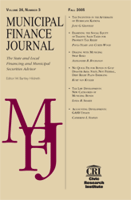Municipal Aid Evaluation and Reform
Author: Bo Zhao.
Source: Volume 36, Number 01, Spring 2015 , pp.27-50(24)

< previous article |next article > |return to table of contents
Abstract:
The distribution of unrestricted municipal aid has been a major policy concern in many states. Using Massachusetts as a case study, this paper examines the extent to which unrestricted municipal aid is responsive to the variation in the underlying fiscal health of municipalities. The paper uses a measure of “non-school cost-capacity gap”—based on local economic and social characteristics outside the direct control of local officials—to indicate the underlying fiscal health of cities and towns. The analysis finds that there are large disparities in municipal gaps among Massachusetts cities and towns and that those disparities have increased in recent years. However, unrestricted municipal aid has not been highly correlated with municipal gaps. This pattern is partly due to large ad hoc cuts in state aid over the past 20 years. This paper suggests that the state consider adopting a gap-based formula that provides more aid to communities facing larger municipal gaps. Policymakers should carefully readjust policy parameters in the formula over time to maintain the political feasibility of the approach. The gap-based framework and policy suggestions are potentially applicable to other states.Keywords: Municipal aid, gap-based framework, municipal fiscal health, non-school aid
Affiliations:
1: Federal Reserve Bank of Boston.